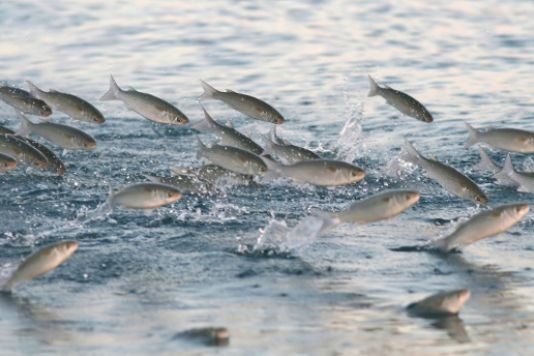Five fish it's safe to eat

Fish classics like cod, salmon and haddock can be delicious, but stocks are low and, with plenty of alternatives, there's no excuse not to eat sustainable breeds. We list five of the best.
I recently read of a waiter whispering to a restaurant critic that the salmon he had eaten was wild (i.e. illegal), but they didn't put that on the menu because they couldn't. The critic was not impressed, and neither was I.
Yes, proper wild salmon is delicious, but so are lots of other sustainably sourced fish. Here, we list five of the best:
Sardines
These oily baby pilchards have fallen out of fashion, but it’s time for a revival. Cheap and tasty, sardines don’t keep well, so they are best gobbled fresh off the barbecue near where they were caught. Failing that, keep an eye out for the brightest and shiniest of the bunch and then cook them quick, or choose a good-quality canned brand.
Fresh sardines are best grilled or fried simply with butter, herbs and lemon or a punchy tomato sauce to balance the oiliness.
They are easy to prepare – descale by holding the small silver fish under the tap and brush from tail to head between your finger and thumb. I like the way James Martin then takes out the bones and grills them simply with a zingy tomato and potato salad, dressed with mustard and lemon juice vinagrette. But you could also try Aktar Islam's Roasted cochin style sardines.
Pollock
The closest substitute for our beloved cod, line-caught Pollack, has firm, white flesh and good flavour. Pollock is now sold in most supermarkets.
Look for a fish with a silver line running along the sides with greenish black skin and a white belly. Be careful not to buy ones less than 50cm long and avoid January-April (breeding season). Other than that, it’s fair, and delicious, game.
Pollock keeps much better than sardines, but still look for shiny eyes and skin, and a vivid pink colour inside the gills if you are buying whole. Like cod, though, it’s better in fillets – check for bouncy and firm flesh.
Because it’s so robust, it can stand up to serious flavours, so it’s great for using in curries or spicy dishes – I love this red thai curry recipe with egg noodles. But you could also try Raymond Blanc’s pollock fillet grenobloise.
Mackerel
The distant relation of the tuna, stocks of mackerel, fished in the north east Atlantic, are in very good shape. Mostly sold whole, mackerel spoil quickly so when buying, check the body of the fish is firm and don’t forget it should have bright eyes and iridescent silver and blue skin.
July is peak season, when mackerel is perfect teamed up with zingy summer ingredients for light salads, or barbecued, but it can also be grilled or stuffed and baked, poached or fried.
The flesh is creamy and flavour is strong. It can hold its own against other ingredients - however, because it’s an oily fish, you need an acidic flavour to cut through. It goes brilliantly with the sharp acidity of rhubarb – I like this recipe.
Lemon Sole
Out of all the soles, lemon is the easiest to get and the best value. But sneakily, it’s not actually a sole at all, it’s a flounder, and has the lovely delicate white flesh shared by plaice and turbot.
Caught in northern European waters, it has a two rating by the fisheries, not the best on the scale, but still a good choice.
It’s best cooked simply, but goes particularly well if you’re doing Asian food with lemon grass, ginger and other similar flavours. The fillets can also be rolled around a stuffing, or packaged up with wine and veggies and cooked en papillote in the oven.
My favourite way to cook lemon sole is as posh goujons. Cut fillets into three and coat first in seasoned flour, then egg and then panko breadcrumbs. Deep fry in hot oil for a few minutes until cooked through, sprinkle with rock salt and serve with lemon wedges and tartar sauce.
Black bream
With dark-grey skin and tough scales, black bream is not the prettiest of fish. But it tastes far better than it looks. In fact, the firm white flesh is a bit like bass, and really underrated.
Not to be confused with freshwater bream, which isn’t worth eating, black bream is fished in the north east Atlantic, where stocks are plentiful and sticking to line caught fixed nets will keep them that way.
Sometimes it is called sea bream at the supermarket, as is gilthead bream – ask if it’s farmed or not and if the answer is yes, it’s not black bream.
All the normal rules for buying apply, bright skin and eyes and no fishy smell. And for cooking, it’s incredibly versatile and tasty whether it’s simply grilled or baked whole, or made more elaborate.
Personally I like it kept with simple flavours like white wine, garlic and herbs. Try it Mark Hix’s way with this recipe.
Also worth your attention:
The return of Cantabrian anchovies
Top five fish and chip shops
Five fabulous fish recipes
Victory for Hugh’s fish fight
Lesley Water’s fish pie recipe
Comments
Be the first to comment
Do you want to comment on this article? You need to be signed in for this feature